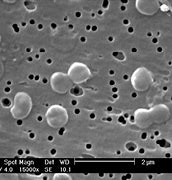Thermococcus atlanticus
Classification
Higher order taxa
Domain: Bacteria Phylum: Deinococcota Class: Deinococci Family: Thermaceae Genus: Thermus
Species
Species:T.aquaticus Binomial name: Thermus aquaticus strain MA898
Description and significance
Thermococcus atlanticus was isolated from deep-sea hydrothermal vents on the Mid-Atlantic Ridge. This Archaeon is extremely thermophilic with a preferred temperature of 85 degrees C. This strain also has an optimal NACL concentration of 3% and pH of 7 for growth. This microorganism requires rich proteinaceous substrates and prefers environments with Polysulfur, L-cysteine, cystine, or elemental sulfur. The strain is an aerobic coccus and grows up to 1.2μm in diameter. Thermococcus atlanticus is an obligate heterotroph that prefers to grow on proteinaceous substrates. The genera of Thermococcus are being studied for biotechnological purposes regarding DNA polymerases or conjugative plasmids. Thermococcus atlanticus is understudied but could lead to future innovations.
16S Ribosomal RNA Gene Information
The Mol% G+C content of the DNA Isolate MA898 was 50% according to thermal denaturation.
Cell structure and metabolism
Strain MA898 of Thermococcus atlanticus is single celled and ranges in size from .7 to 1.2 μm. the cells were observed as being nonmotile. The cells likely divided through constriction. The cells have a slightly irregular cocci shape and live as a form of plankton. This microbe is an obligate anaerobic chemoorganotroph.
Ecology and Pathogenesis
T.atlanticus is found in the mid-Atlantic Ocean at deep-sea hydrothermal vents. They thrive in high-temperature and high-pressure environments. It also preferentially grows in the presence of elemental sulfur, polysulfur, cystine, or L-cysteine. This strain also requires a protein rich substrate. This species was found in the chimney wall of hydrothermal vents, it is a new hyperthermophilic, heterotrophic archaeal species.
References
Cambon-bonavita, M., Lesongeur, F., Pignet, P., Wery, N., Lambert, C., Godfroy, A., Querellou, J., & Barbier, G. (2003). Extremophiles, Thermophily section, species description Thermococcus atlanticus sp. nov., a hyperthermophilic Archaeon isolated from a deep-sea hydrothermal vent in the Mid-Atlantic Ridge. Extremophiles, 7(2), 101-9. https://doi.org/10.1007/s00792-002-0301-8
Author
Maura Cleary
Students of Hidetoshi Urakawa at Florida Gulf Coast University



